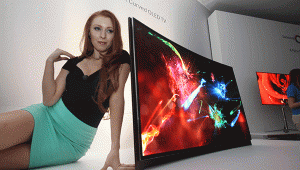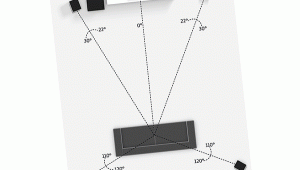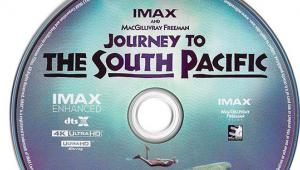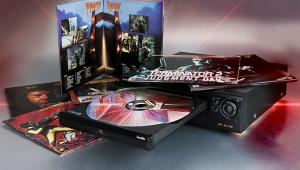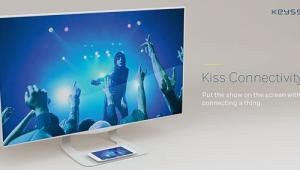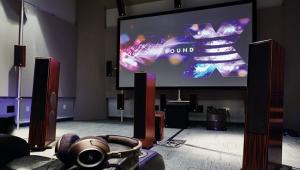Revealed: Everything you need to know about 4K!
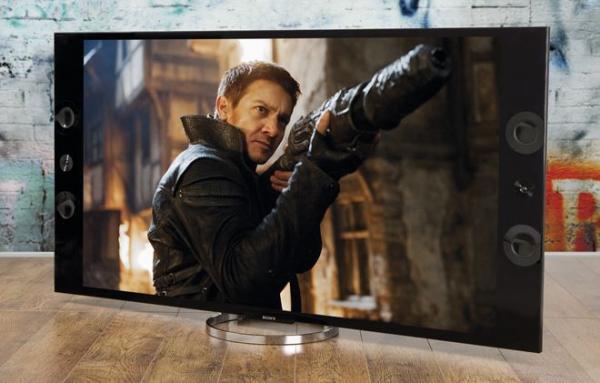
Right. I’m hearing an awful lot about 4K, but why should I be excited?
You know how juiced you were about the arrival of high-definition? Well, imagine that excitement magnified four-fold. 4K TVs deliver four times the picture resolution of HD, allowing you to see hitherto unparalleled detail in movies and still photography.
I keep hearing about Ultra HD as well? Is there a difference?
Technically, yes. The Ultra High Definition handle was coined by the US Consumer Electronics Association as a catch-all for televisions offering a minimum of 3,840 x 2,160 resolution; the idea was to help communicate the idea that the format was a step up from regular Full HD. The term has been widely adopted, but some manufacturers are reluctant to relinquish the 4K branding. In truth, 4K is rapidly becoming a bit of an umbrella term to describe a variety of different technical standards, much to the annoyance of tech pedants everywhere.
2160p UHD is a derivation of the 4K digital cinema standard, which is actually native 4,096 x 2,160 (there are other variations in the movie-making world, depending on the preferred aspect ratio of the moviemakers concerned, but let’s not get bogged down in additional minutia). 4K films composed for theatrical distribution are cropped for home viewing. The film-makers aren’t concerned about a few hundred missing pixels and neither should you be.
Okay, so I want a 4K/Ultra HD TV – but these are super-expensive, right?
Inevitably, new display technologies will always be more expensive than established products simply because they need to recoup research and development costs, plus they can’t benefit from economies of scale when it comes to production. But things move fast in the world of TV tech. The first two 4K screens launched were 84in monsters from LG and Sony. The LG 84LM960V debuted at £22,000 (but is now available for around £16,000), while Sony’s KD-84X9005A sold for around £25,000. These were followed by Samsung's £35,000 S9 TV. But these are hero products and not indicative of where 4K technology is heading. Sony’s 55in KD-55X9005A and 65in KD-65X9005A launched at at a more approachable £4,000 and £6,000 respectively. And as rival screens from the likes of Toshiba, Philips and Panasonic roll out, prices are continuing to erode – Toshiba's 58in 4K TV (the 58L9363) is priced at around £3,000. No one in the business expects 4K TVs to hold onto a big price premium for very long.
What about a 4K projector? I want to go large!
Surprisingly there’s not a lot happening on the 4K front when it comes to consumer projectors. Sony broke new ground with the VPL-VW1000ES, a £16,000 quasi-pro SXRD model, and is has also now launched a cheaper model, the £8,500 VPL-VW500ES. One contributory factor is the price of precision optics needed to deliver an Ultra HD image.
However, it will be some time before we see numerous mainstream 4K home cinema PJs. This is because Texas Instruments has partnered with digital cinema projector makers Barco and Christie Digital Systems to develop a 4K DLP solution, and as part of that deal has signed a non-compete clause which prevents it producing 4K DLP chips for home use. Alan Roser, managing director of SIM2 UK, told HCC: '4K is perfect for home cinema projection, but we won’t really see it until 2015 when TI is in a position to ship 4K chipsets. [Then] the floodgates will open.'
Sony's VPL-VW1000ES – setting the standard for 4K home projection
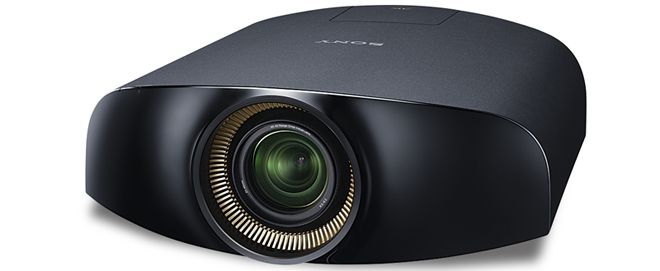
Fine, I’ll look at a TV then. Are they any good?
It’s early days yet for the 4K format, but there’s little doubt that this is game-changing stuff when it comes to home cinema. For aficionados seeking the highest level of clarity, 4K screens can’t be beaten. With native 4K content there should be literally no difference between a 4K studio master and what you experience onscreen, which makes it the Holy Grail of home theatre. Of course, while we wait for native 4K content to arrive, the real question is just what does the screen do with Full HD material. The answer is quite a lot, as it happens. By way of example, Sony’s X9 TVs do a phenomenal job with upscaling HD. The biggest beneficiary is Blu-ray. Discs mastered from a 4K source retain some high-frequency information which can be interpolated as additional detail. Furthermore, Sony's new Mastered in 4K Blu-rays offer a wider colour gamut that, when displayed on a compatible set – one of the brand's Triluminos models, for instance – delivers redder reds, bluer blues and more verdant greens.
Will I need to update my Blu-ray player and AV receiver to ones offering 4K upscaling?
4K TVs bought today work perfectly well with existing BD players and AV receivers. However, if you are looking to upgrade your AV receiver, shortlist models that offer 4K passthrough and upscaling. This functionality is rapidly becoming a standard option on higher-spec AVRs, such as the Onkyo TX-NR828 and TX-NR929 and the Pioneer SC-LX57, SC-LX77 and SC-LX87. Without 4K passthrough your 4K video source will not route through the receiver; you’ll need to take your HDMI feed direct. The actual value of 4K upscaling in an external source component, though, remains to be seen, as all 4K displays already incorporate advanced image processing to do the job. Common sense would suggest the electronics in a £6,000 TV will trump those in a £150 deck.
OK, but will I need special HDMI cables?
No, any branded HDMI lead should work fine…
Upscaling Blu-ray sounds interesting, but what genuine 4K content is out there?
At present there’s not too much available. If you have a high-end PC with a 4K-capable graphics card, you’ll be able to watch a small selection of material from YouTube’s dedicated 4K channel, as well as some games content. Hopefully native 4K material really isn’t that far away. The Blu-ray Disc Association has a working group looking at how best to accommodate 4K within the Blu-ray specification. If and when its recommendations are accepted, you can expect a new generation of 4K-capable Blu-ray players to be launched, as well as a new catalogue of 4K Blu-ray discs.
Before 4K can be more widely assimilated, new compression technologies need to be adopted. Gaining the greatest traction is HEVC (High Efficiency Video Coding). Heralded as the long-term replacement for H.264, HEVC is powerful enough to enable 4K delivery of terrestrial TV signals and has been successfully trialled with over-the-air broadcasts in Korea and internet streaming in Japan.
Of course, HEVC isn’t the only compression game in town. Both Sony and Netflix are working with Eye IO, which has its own compression solution optimised for internet applications. In the States, Sony is launching the world’s first 4K movie rental service using the codec, called Video Unlimited 4K. Twenty-four-hour 4K movie rentals are priced at $7.99, with 4K movie downloads available for purchase at $30. The service is only open to owners of Sony’s 4K TVs, and requires the purchase of the brand’s FMP-X1 media player. It’s not clear if and when this will be rolled out to the UK and Europe, but Sony has stated that at some point the new PlayStation 4 games console will provide a gateway for 4K video delivery.
What about 4K on broadcast TV?
While early terrestrial TV trials using HEVC compression in Korea have been extremely successful, there are no concrete plans for the likes of Freeview to go 4K anytime soon. Indeed, Managing Director Ilse Howling has categorically stated that the platform isn’t interested, not least because it doesn’t want to disenfranchise owners of existing Freeview hardware. For 4K reception a new set-top box would be required. 'It’s not in our plans,' she told HCC. 'Here at Freeview, we want to just keep pace with the needs of our customers. I really don't think Freeview is about being cutting edge…'
The situation with satellite TV is somewhat different. It’s extremely likely that Sky will debut 4K subscription channels at some point. The broadcaster has been trialling live sports coverage and would clearly have no problem sourcing 4K movie content, given its existing licensing arrangements with Hollywood. All it actually needs is a sizeable population of 4K screens and the silicon to implement a new 4K-ready Sky+HD set-top box. Expect to hear a lot more about this come 2015…
Toshiba's L9 series of 4K TVs includes a 58in model
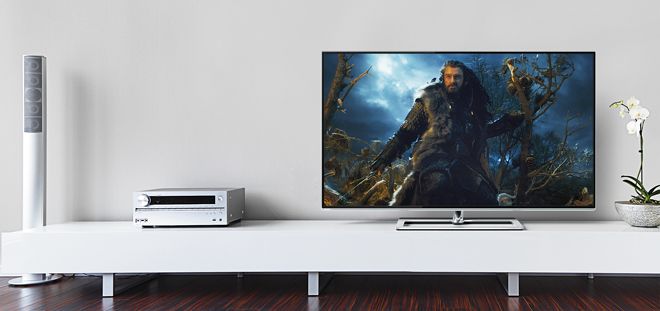
Do I need a super-large TV screen to get 4K, or will it be available in regular screen sizes?
It’s not true that you need a huge screen to appreciate 4K resolution. Panasonic has shown off a stunning 3,840 x 2,160 pixel 20in tablet, but it’s admittedly designed for specialist applications such as design and photography. In the living room, 55in is generally seen as the starting point for 4K viewing, with 65in to 85in providing the sweet spot.
I doubt I could accommodate such a screen in my house. My living room isn’t big enough…
The cool thing about 4K screens is that you don’t need a large room. As President of Sony Pictures Technology, Chris Cookson explains: 'New largescreen 4K TVs are not meant to be viewed from further away. If you have a 50in TV now, you would take that out, put a bigger 4K one in and not move your chair.' It’s all about filling up your field of vision with more information – and your eye is capable of perceiving that information when you’re that close. A good viewing distance for 4K is 1.5x screen height. 4K effectively rebalances the relationship between the eye of the viewer and the picture on the screen, says Cookson. Cinemas were once shoebox-shaped and patrons sat typically 3-5 screen heights away, he says, 'because that’s where the image was the most comfortable.' Today’s cinemas are wider and movie-goers sit 1.5 screen heights back, as there’s far more information on the screen and viewers can sit closer comfortably.
Given that 4K standards are still evolving, how futureproof is a 4K TV bought today?
The biggest change on has been the introduction of HDMI 2.0. This increases the potential bandwidth of 4K from the previous 30Hz limit to 60Hz. While this is unlikely to affect 4K Blu-rays (with the isolated exception of a few Hobbity high frame-rate movie releases), it could impact broadcast 4K if 50/60Hz is adopted as a TV standard. Manufacturers of first-gen 4K TVs are already talking about making them HDMI 2.0-compatible via either separate tuner boxes or firmware updates. Panasonic has launched the first HDMI 2.0-equipped 4K TV in the shape of its 65in WT600.
Be honest now, is this technology really going to take off? In the past I’ve bought a Betamax deck, an HD DVD player and an 11in OLED TV…
Talk to content providers and they’ll tell you 4K has already taken off. John Anderson, head of home entertainment for Sony Europe says there’s no way 4K will become a 3D-style fad. 'You only have to look at just how many of this year’s Oscar winners were 4K productions to realise that,' he told us. And his colleague Chris Cookson describes the development of 4K as 'part of a process that’s been going on since the invention of television.' With 4K digital projection fast becoming the standard for cinema presentation, it was inevitable TV would catch up, he says.
In fact, Sony is no longer shooting any new TV pilots in HD; the studio has a mandatory policy to film them all in 4K. 'We want to make sure that what we put into the vaults today, you’ll be able to watch in 4K resolution ten years from now.' Cookson adds that shows shot today have an extended colour range and better dynamics than anything shot in HD: 'It’s important that the things we produce today can stand up in the market 15-20 years from now.' Hollywood has also been remastering its classic library titles at 4K resolution for years. Anderson adds: '4K is a consumer reality already, and it’s well on its way to becoming the next standard.'
 |
Home Cinema Choice #351 is on sale now, featuring: Samsung S95D flagship OLED TV; Ascendo loudspeakers; Pioneer VSA-LX805 AV receiver; UST projector roundup; 2024’s summer movies; Conan 4K; and more
|




